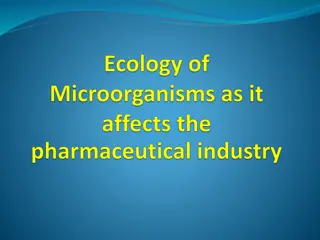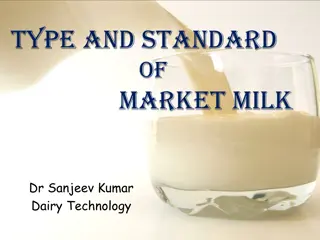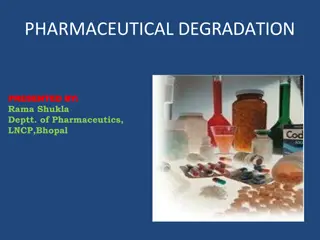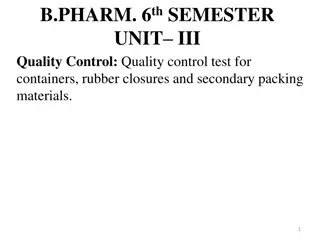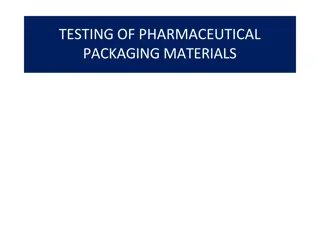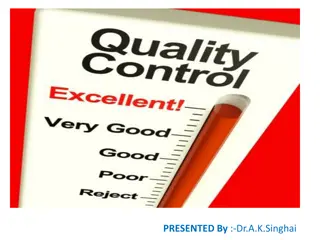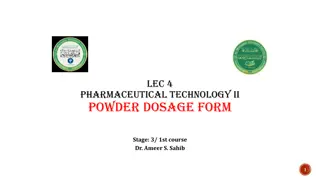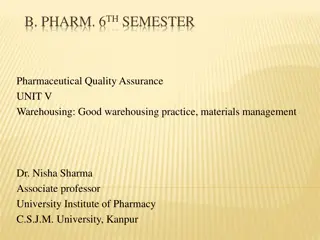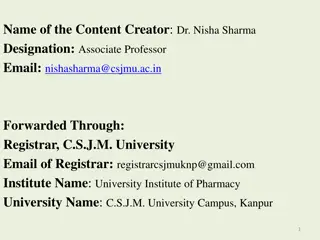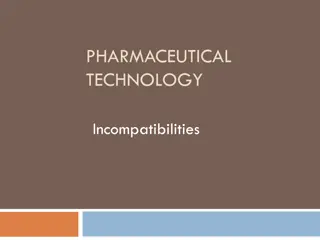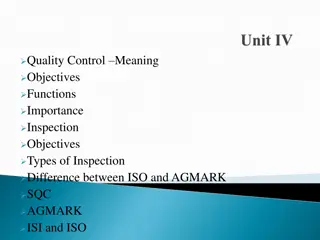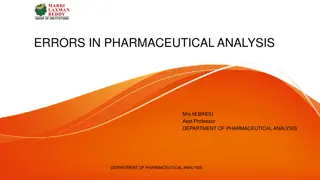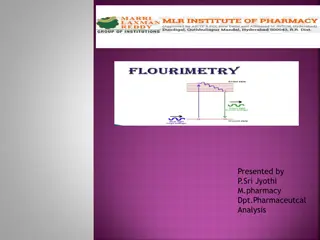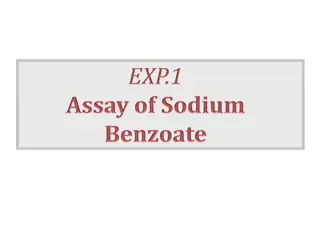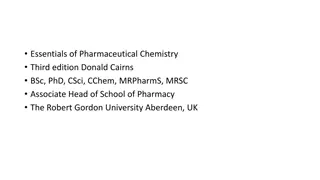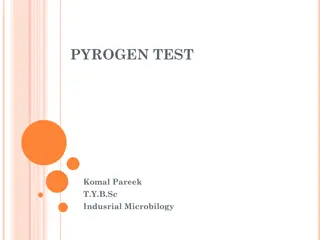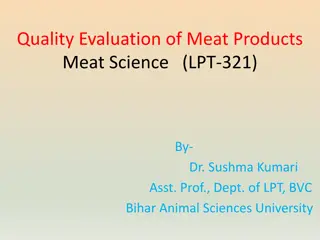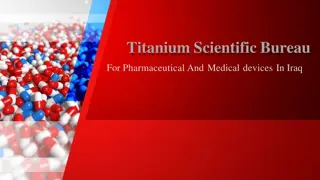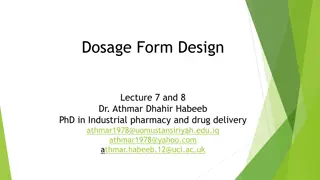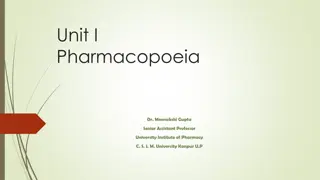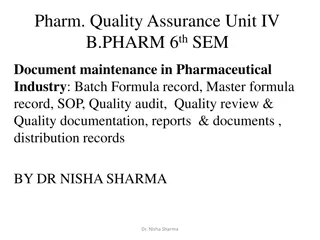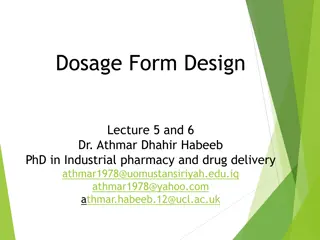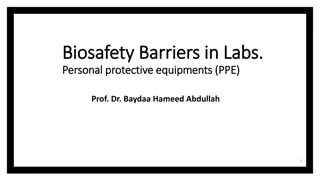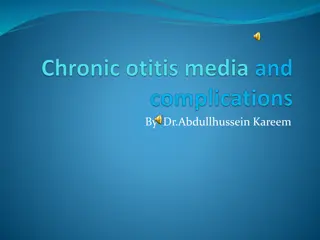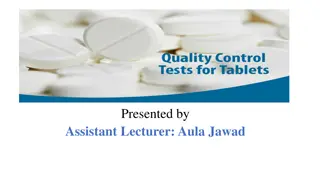Microbiological Quality Control in Pharmaceutical Environment
Microbiological products in pharmaceutical settings are influenced by the quality of materials and the environment. Good Manufacturing Practices (GMP) are essential to minimize contamination risks, with control points focused on the ecology of microorganisms. Sources of contamination include the atmosphere, water, individuals, raw materials, and equipment. Methods for checking air quality range from simple to quantitative approaches. Reduction of microbial counts in the air can be achieved through filtration, chemical disinfection, UV irradiation, and compressed air sterilization.
- Microbiological quality
- Pharmaceutical environment
- Good Manufacturing Practices
- Contamination risks
- Air quality
Download Presentation

Please find below an Image/Link to download the presentation.
The content on the website is provided AS IS for your information and personal use only. It may not be sold, licensed, or shared on other websites without obtaining consent from the author. Download presentation by click this link. If you encounter any issues during the download, it is possible that the publisher has removed the file from their server.
E N D
Presentation Transcript
Microbiological products is influenced by: quality of pharmaceutical Environment Materials
Good Manufacturing Practices (GMP) It is developed to minimize contamination by a study: Ecology of microorganisms Hazards posed by them Control the critical points in the process
The source of pharmaceutical products contamination: Atmosphere Water Persons (Skin & respiratory tract flora) Raw materials Packaging Buildings Equipment Cleaning equipment & utensils
1. Atmosphere Microorganisms commonly isolated from air are: * Spore- forming bacteria: Bacillus spp.; Clostridium spp. * Non- sporing bacteria: Staphylococcus spp.; Streptococcus spp.; Corynebacterium spp. * Moulds: Penicillium spp.; Aspergillus spp.; Cladosporium spp.; Mucor spp. * Yeasts: Rodotorulla spp.
Methods for checking the microbiological quality of air: Simple methods: including, exposure of petridishes containing a nutrient agar to the atmosphere for a given length of time (not more than 7 hours). Quantity methods: including, use of an air- sampling machine which draws a measured volume of air from the environment and impinges it on a nutrient agar surface on either petridishes, plastic strip or a membrane filter, then incubated with a nutrient medium.
How can reduced the microbial count of air: It may be reduced by: Filtration: It is the most commonly used method, using laminar flow, which sterilizing air by permits to passage through a High Efficiency Particulate Air (HEPA) filter, to remove all particles in excess of 0.1-0.3 um in size. Chemical disinfection: Chemical disinfectants are limited in their use as air sterilants because of their irritant properties when sprayed. Like propylene glycol; quaternary ammonium compounds. UV irradiation at wave lengths 240-280 nm, it used to reduce bacterial contamination of air. *Note: The combination of UV light & air filtration gives useful results in air sterilization. Compressed air: It has many applications in the manufacture of pharmaceutical products, it is used in the conveyance of powders & suspension. Compressed air is sterilized by heat & filtration.
The number of organisms in the air depends on: * Activity in the environment. * Amount of dust that is disturbed. usually content of air is increased in the summer more than winter. The movement of microorganisms in the atmosphere: Microorganisms are carried into the air suspended on: o * Dust o * Skin or clothing o * Droplets of moisture o * Sputum following talking, coughing, sneezing.
2. Water The microbial ecology of water is of great importance in the pharmaceutical industry owing to its multiple uses as constituent of many products as well as for various washing & cooling processes. We can divided the water which used in pharmaceutical industry into many types: A. Raw water or mains water: The quality of the water from the mains supply varies , when the supply is derived from surface water the flora is usually more abundant(microorganisms & nutrients introduced from soil& sewage) than that of supplies from a deep- water (its microflora filtered out).
Microorganisms indigenous to fresh (mains) water: Pseudomonas/ Alcaligenes/ Chromobacter/ Sertia. On prolonged storage in the industrial storage tanks, the bacterial count may rise rapidly during summer months and reach 105 10 6 per ml. * Uses of raw water: Washing & cleaning. * Note: The microbial count of the mains water will reflected in both softened & deionized water which may prepared from it.
B. Softened water: It is prepared by either : Base- exchange method, using sodium zeolite or, by addition of sodium hexametaphosohate. In addition to the bacteria derived from the mains water, additional flora of Bacillus & Staphylococcus aureus may be introduced into system Uses of softened water: - Washing of containers. - For cooling systems. *Unless precaution are taken, the microbial count in cooling system or jacketed vessel will rise rapidly & if faults develop in cooling pates or vessel wall, contamination of the product may occur.
C. Deionized or demineralized water: It is prepared by passing raw water through anion and cation exchange resin beds to remove the ions. Thus, any bacteria present in the mains water will also be present in the deionized water, and beds which are not regenerated frequently with strong acid or alkaline are often heavily contaminated & add to the bacterial content of the water. * Uses of deionized water: Its used in: - pharmaceutical formulations - washing containers - preparation of disinfectant solutions.
D. Distilled water: It is free from microorganisms, and contamination occurs as a result of a fault in the cooling system, the storage vessel or the distribution system. The flora of contaminated distilled water is usually Gram- negative bacteria. Uses : It is used in: -Formulation of oral & topical pharmaceutical preparations, and low bacterial count is desirable. -Manufacture of parenteral preparations and a post- distillation heat sterilization stage is commonly included in the process. * Water for such preparation is stored at 80C to prevent bacterial growth & the production of pyrogenic substances.
E. Water produced by reverse osmosis(RO): It is forced by an osmotic pressure through a semi- permeable membrane which acts as a molecular filter, which prevents molecular in excess of 250 Dalton from passing . The process, which is the reverse of the natural process of osmosis, thus removes microorganisms and their pyrogens. Post- RO contamination may occur if the storage vessel or the distribution system is not kept free from microorganisms.
F. Distribution System: An optimum distribution system for reducing growth of microbial flora is: - Ensures a constant recirculation of water at a positive pressure through a ring- main without dead- legs . - Only very short branches to the take- off points. - There should be a system to re-sterilize the water, usually by membrane filtration or UV light treatment, just before return to the main storage tank.
Disinfection of water: There are chemical& physical methods used for treating water. Chemical treatment: * Sodium hypochlorite & chlorine gas are common agents for treating water supply itself in concentration 0.5 5 ppm for most purposes 50 100 ppm for storage vessels, pipelines, pumps. 1% formaldehyde solution for treated RO systems, distilled, deionized water. Physical methods: Filtration: membrane filtration is useful where the usage is moderate & continuous circulation of water . UV light : 254 nm is useful for the disinfection of water of good optical clarity.
3. Persons: Microorganisms may be transferred to pharmaceutical preparations from the process operator. Natural skin flora may contaminated the products: Staphylococcus aureus: it is common on hands& face. Saprophytic bacteria: from ear secretions. Dermatophytic fungi: from different parts of the body. * Bacteria other than skin flora may transferred from operator as a result of poor personal hygiene is E.coli .
For the manufacture of products intended for injection & eye or ear preparations, it is necessary for the operators to: - Wear sterilized clothing, trousers, boots, face masks, gloves, .etc. - Washing their hands before entering the production area.
4. Raw materials: Raw materials account for a high proportion of the microorganisms introduced during the manufacture of pharmaceuticals, and the selection of materials of a good microbiological quality aids in the control of contamination levels in both products & the environment. It is accept to raw materials, have some non- pathogenic microorganisms. Microflora of untreated raw materials, various depending upon natural sources, which derived from it.
Sources of raw materials: a. Natural source b. Synthetic source a. The natural sources divided into: 1. Animal source 2. Plant source Products from animal source: gelatin, desiccated thyroid , pancreas. Contaminated with animal- borne pathogens like: E. coli, Salmonella. b. Synthetic source: Usually raw materials from this source free from contaminants, but incidental microbial contamination. Products from plant origin: gum, agar, starches. Contaminated with: Bacteria: Erwinia, Pseudomonas, Bacillus, Lactobacillus, Streptococci. Moulds: Cladosporium, Alternaria, Fusarium. 1. 1. 2. 2.
Note: Raw material should be stored at(Aw)under 0.65. How can reduce the microbial count of raw materials: By sterilization procedures, include: - Heat treatment - Filtration - Irradiation - Recryatallization from bactericidal solvent such as alcohol, or for dry products ethylene oxide gas.
5.Packaging: Packaging material has acts to contain the product & to prevent the entry of microorganisms or moisture which may result in spoilage, and it is therefore important that the source of contamination is not the packaging itself. The microflora of packaging materials is dependent upon : * Its composition. * Storage conditions.
Containers used in packaging: There are tow types of containers: a. Glass containers: Are: b. Plastic bottles: That: Have low microbial count. Contaminate during transport. Thus, - Used a moist heat or ethylene oxide gas or formaldehyde to sterilized the plastic bottles. Sterile when leaving furnace. Stored in dusty conditions & packed in cardboard boxes. Contaminate during packed & transport. Thus, - Wash glass containers to remove dust which present. - Include a disinfection stage if the product being filled is liquid or semi- solid preparation. - In the case of injectables & ophthalmic preparations which are manufactured aseptically but do not receive a sterilization treatment in their final container, the packaging has to be sterilized. - Dry heat used for vials & ampoules.
Closure liners of pulpboard or cork considers a source of microbial contamination, thus, must be treated with preservatives, foil, wax coating in liquid or semi- solid preparations. A closure with a plastic flowed-in liner is better than one stuck in with an adhesive, especially on a natural product (like casein). Note: Containers & closures must be sterilized by chemicals & irradiation to reduced the microbial contamination of the final products.
6. Buildings: There are include, walls, ceilings, floors, drains, doors, windows, & fittings. Common flora of walls & ceilings: Moulds are the most common flora like: Cladosporium/ Aspergillus/ penicillium/ Aureobasidium To reduce microbial contamination of buildings: - All walls & ceilings should be smooth, impervious & washable . - Painted with hard gloss finish. - Addition of up to 1% of fungistate. - In areas where aseptic filling operations are carried out it is useful to have a false ceiling with the services or lighting & ventilation sited above it. - The joint between the false ceiling & the room below is well sealed. - All electric cables & ducting for other services should be installed deep in cavity walls. - All floors should be easy to clean & to slope towards a drain, no pools of water form.
- In areas where acid & alkaline chemicals or cleaning fluids are applied, a resistant sealing & jointing material must be used to prevent pitted & porous formed. - Floor drainage channels should be open, shallow & easy to clean. - Drains should be outside areas ,where sensitive products are manufactured. - All doors & windows should fit flush with walls to prevent dust from collecting. - All windows in manufacture should serve only to permit light entry & not be used for ventilation. - Stainless steel piper support little microbial growth, but lagged pipes present a problem and must be treated with disinfectant.
7. Equipment: Each piece of equipment used to manufacture or pack pharmaceuticals has its own peculiar area where microbial growth may be supported. * To reduce the risk of microbial colonization in equipments: 1. All equipment should be easy dismantle & clean. 2. All surfaces that are in contact with the product should be smooth, continuous, free from pits & eliminate sharp corners and junctions must be rounded. 3. All internal welding should polished out & there is no dead ends. 4. There should be no inside screw threads & all outside threads readily accessible for cleaning. 5. Coupling nuts on all pipework & valves should be capable of being taken a part and cleaned. 6. Mechanical seals are preferable to packing boxes as packing material & must be far away from product lines. 7. Valves should be of a sanitary design, and all contact parts must be treated during cleaning & sanitation.
8. All pipelines should slope away from the product source and all process and storage vessels should be self- draining. 9. If a vacuum exhaust system is used to remove the air or steam from a vessel, it is necessary to clean & disinfect all fittings regularly. 10. Cleaned & sterilized regularly filters or straining bags made from natural materials, to prevent the growth of moulds. * Sterilization and disinfection of equipment: Equipment may be sterilized or disinfected by heat, chemical disinfection or by combination of both. * Microbial cheeks: The efficacy of cleansing- in- place(CIP) system can be checked by plating out a sample of the final rinse water with nutrient agar, or by swab test.
9. Cleaning equipment & utensils: The misuse of brooms & mops can substantially increase the microbial count of the atmosphere by raising dust or splashing with waterborne contaminants. To prevent this, either a correctly designed vacuum cleaner or a broom made of synthetic materials, which is washed regularly. Use of a neglected dry mop may redistributes microorganisms which it has picked up, but a neglected wet mop redistributes many times the number of organisms it picked up originally. In order to maintain mops and similar non- disposable cleaning equipment in a good hygienic state, at first wash & then to boil or autoclave the items, and finally to store them in a dry state. Disinfectant solutions were found to be inadequate.
Many chemical disinfectants like halogens & QACs are inactivated in the presence of organic matter, thus, all cleaning materials( buckets & fogging sprays) are kept clean. The bulk of the disinfectant must be store in a concentrated form and diluted to use concentration as required.
Chemical disinfectants, antiseptics and preservatives.
Disinfectants are chemical agents which are used to destroy microorganisms on inanimate (dead) objects. Antisepticsare chemical agents which are used to destroy or inhibition of microorganisms on living tissues. Disinfectant does not necessarily kill all microorganisms, but it reduces them to a level which is acceptable for a define purpose. The term disinfectant can be used to include antiseptics, in a wider sense ( but British Standards Institution consider antiseptic is not a synonym for disinfectant).
Antiseptics have more selectivity in their action toward the bacteria than the living tissues, at the recommended concentration ,therefore antiseptics usually exert a bacteriostaticor low bactericidal effect at the recommended concentration. Antiseptics must not be toxic or irritating to skin, and they are often lower concentrations of the agents used for disinfection. Disinfectants on the other hand are non selective, irritant, corrosive or toxic to be applied to the skin or to tissues.
Preservatives: These are included in pharmaceutical preparations to prevent microbial spoilage of the product and to minimize the risk of the consumer acquiring an infection when the preparation is administered. Preservatives must be able to limit proliferation of microorganisms introduced unavoidably into non- sterile products( oral& topical medications) during their manufacture and use, while in sterile products(eye drops and multi- dose injections) preservatives should kill any microbial contaminants during use. that may be introduced inadvertently
Preservative is not toxic, and employed at lower concentrations, and levels of antimicrobial action lower order than for disinfectants or antiseptics(European Pharmacopoeia ). There are around 250 chemicals that have been identified as active components of microbiocidal products in the European Union.
Factors affecting choice of antimicrobial agent:(P:286) Properties of the chemical agent. Microbiological challenge. Intended application. Environmental factors. Toxicity of the agent.
Factors affecting the activity of antimicrobial agents: 1- Temperature: In general, as the temperature increased in arithmetical progression, the rate of kill increase geometrically. The effect of temperature increase on the rate of bactericidal activity at a fixed concentration and inoculum size is expressed quantitatively as a temperature coefficient, usually in 10value: which is the change in activity per 100C rise in temperature, e.g. rising the temperature of phenol from 200C to 300C increased the killing activity by a factor of 4. 10value may be calculated by determining the extinction time at two temperature differing exactly by 100C. 10 =Time require to kill at T0 Time require to kill at(T+10)0 * This value is constant for each compound. Compounds with high 10 are more effective with increases in temperature than those with low 10.
10 Compound Aliphatic alcohol 30- 50 Phenols 3- 5 Formaldehyde 1.5
2- Concentration: The rate of kill of bacterial population is directly affects with concentration or dilution, therefore slightly increase or decrease in the concentration of certain agents can increase or decrease their bactericidal effect. The graph plotting the log 10of a death time(i.e. the time required to kill a standard inoculums) against the log10of the concentration is usually a straight line, the slope of which is the concentration exponent( ) = concentration exponent (dilution coefficient),which is measure the effect of changes in concentration(or dilution) on cell death rate =log t2 log t1 log c1 log c2 It is constant for each compound, and the dilution does not affect the cidal attributes of all disinfectants in a similar manner. Therefore compounds with low are less affected by dilution, but those with high will be readily inactivated.
Compound No. of dilution Reduce the activity (the time required) 21 double the time Mercuric chloride 1 2 31 three times Formaldehyde 1 3 Phenol 6 26 64 (the time) 36 726 (the time) 1/3
: 3-PH Changes in PH of the medium affect both bacterial cell and disinfectant activity. Bacterial growth is optimums at PH 6- 8, any change in this PH will decrease the bacterial growth as well as change the physicochemical state of their surface. The degree of ionization of acidic or basic disinfectant will obviously depend on the PH.
4- Formulation: Formulation is greatly affect the activity of the disinfectant and the recommendation of the manufacturer for dilution should strictly be followed. This is because that penetrating power and hence the effectiveness of some agents such as chlorhexidine and QAC may be greater in 70% alcohol than in aqueous solutions. Phenols have low solubility in water, therefore concentrated solutions are prepared used soap, hydrocarbon carriers. Iodine have low solubility in water, therefore alcohol, potassium iodide solution or surface active agents are used to dissolved it.
5- Physicochemical factors: Although the action of disinfectant depend largely upon its adsorption & penetration through bacterial cell wall and cytoplasmic membrane and or reaction with cellular constituents yet these processes depend largely upon a- molecular size b- configuration c- partitioning of germicide. The presence of other substance in solution can greatly effect the previous phenomenon of these substances. A. Nature of solvents: the nature of solvent is important in relation to the partition coefficient of the germicide. Water is the best media for the action of germicides, since bacteria can grow therefore only in this medium, therefore the addition or the presence of any other material which attracts the germicide will effect its concentration in water, thereby, it will reduce its concentration in the effective site. Oils, fats and glycols depress the activity of phenol in this way. On the other hand compounds with high partition coefficient might be more effective against microorganisms of high lipid content e.g. Mycobacterium tuberculosis, and other acid- fast bacilli.
B. Soaps: soaps increase the activity of phenol because it reduce the surface tension and aids the contact of the disinfectant with bacterial cell and perhaps it increases the permeabilityof thecell membrane. QAC like benzalkonium chloride may act by this way as well as many sanitizer( which are used in cleansing utensils and equipments) which contain detergents. 6. Interfering substance in theenvironments: Organic materials such as blood, pus, saliva, mucous, milk, food, feces(stool) and proteinous material, highly influence the effectiveness of disinfectant. This is because of adsorption or chemical interaction or shielding of microorganisms from adequatecontact with the germicide.
Off the compounds which are largely affected, are biguanides; chlorhexidine, QAC, chlorine compounds & some phenolic disinfectants. Organic materials such as fabrics, rubber, cork and plastics are also capable of adsorbing certain disinfectant. Soaps and anionic detergents can inactivate QAC. Thiol groups can react with mercurial's. Diluted phenoliccompounds such as chloroxylenols lose activity on standing due to change in the physical state of the emulsion also hard water may break emulsions & precipitate soaps.
7. Nature, number and location of microorganisms: The kind & the number of microorganism greatly affect the power of disinfection, in general, vegetative bacteria are the most sensitive sort of microorganisms followed by fungi, viruses and the most resistance forms are the bacterial spores. Off the vegetative bacteria the G+veare more sensitive than the G-ve. High inocula of microorganisms needs higher concentration of disinfectant due to inactivate of these agents with organic depress. The presence of water( aqueous solution) is essential for chemical disinfection. Dried blood film, mucous, feces, sputum may prevent the penetration of disinfectant, therefore, the cleansing with tap water is required before disinfection.
Levels of Germicidal Action
1. High Germicidal: (p:286) Killed all microorganisms unless extreme challenge or resistance exhibited. M. surviving ( challenge of resistant bacterial spore, prions) Bactericidal, Sporocidal, Fungicidal & Virucidal e.g. Ethylene oxide, Formaldehyde, Glutaraldehyde. 2. Intermediate Germicidal: Killed most vegetative bacteria including M. tuberculosis, most viruses including hepatitis B virus (HBV), most fungi. M. surviving (bacterial spores, prions) Bactericidal, Non- sporocidal, Fungicidal &Virucidal e.g. Alcohol, Chlorine compounds & Iodine solution. 3. Low Germicidal: Killed most vegetative bacteria, some viruses, some fungi. M. surviving (M. tuberculosis, bacterial spore, some viruses, prions) Bactericidal, Fungicidal & kill lipid viruses only e.g. Chloroxylenoles, Thiomersal, QACs, Chlorhexidine, Iodophors.


